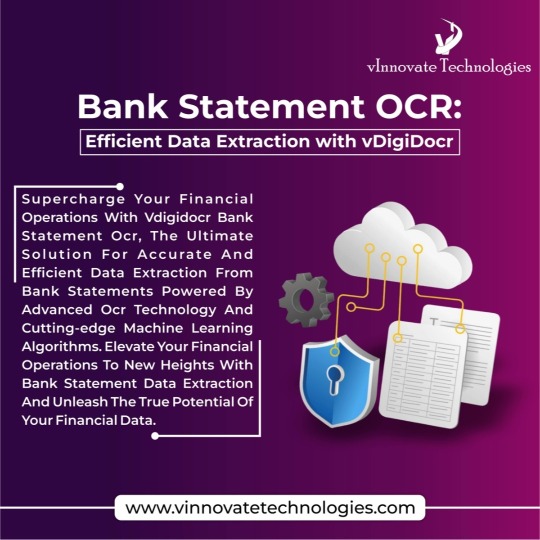#DocumentIntelligence
Explore tagged Tumblr posts
Text

What's New in Docketry!
It is high time to safeguard your data with advanced document intelligence! Cut fraud detection time with Docketry and boost accuracy to 95%!
Contact us at +1 888 811 5199 to discover how AI can transform your security measures!
Visit: https://docketry.ai/
0 notes
Text

Unlock Effortless Bank Statement Processing with vDigiDocr OCR Streamline your financial data extraction with vDigiDocr are cutting-edge Optical Character Recognition (OCR) technology, tailored for seamless bank statement processing.
#BankStatementOCR#OpticalCharacterRecognition#DocumentIntelligence#FinancialDataExtraction#AutomatedDataEntry#DocumentManagement#AI#MachineLearning#digitaltransformation
0 notes
Text
How can AI models handle complex and diverse documents?Check out our new article on JPMorgan’s DocLLM, a new AI model that excels in visually rich form understanding tasks.It incorporates spatial layout into language generation.This novel AI model can extends large language models with disentangled spatial attention. Learn more about DocLLM, its features, its architecture, its performance and more and share your thoughts with us.
#artificial intelligence#ai#open source#machine learning#machinelearning#DocLLM#JPMorgan#AI#DocumentIntelligence#Multimodal#SpatialLayout#OCR#jp morgan#programming
0 notes
Text
Maximizing Efficiency with Contract AI and O2C Automation

Contract AI (Contract Artificial Intelligence):
Contract AI refers to using machine learning and artificial intelligence (AI) technologies to streamline and optimize the management of contracts throughout their lifecycle. It involves the application of AI algorithms to analyze, extract, and interpret data from contracts, automate contract-related processes, and improve contract risk management and compliance. Contract AI aims to enhance efficiency, reduce manual labor, mitigate risks, and facilitate better decision-making in managing legal agreements and contracts within organizations.
O2C Automation (Order-to-Cash Automation):
O2C Automation, also known as Order-to-Cash Automation, implements automated processes and technologies to optimize and streamline the entire order-to-cash cycle in a business. This cycle encompasses all the steps in fulfilling customer orders, from order initiation to payment receipt. O2C Automation typically involves robotic process automation (RPA), workflow automation, and data analytics to improve order processing efficiency, reduce errors, enhance cash flow management, and provide a better customer experience. It plays an important role in financial and customer relationship management within organizations, particularly in the BFSI (Banking, Financial Services, and Insurance) sector. Explain their significance in the BFSI (Banking, Financial Services, and Insurance) sector.
Discuss the need for modernization in BFSI
Modernization in the Banking, Financial Services, and Insurance (BFSI) sector is imperative due to the convergence of technological innovation, shifting customer expectations, stringent regulatory demands, and heightened competition. BFSI institutions must embrace digital transformation to stay relevant and competitive, providing seamless and personalized services while adhering to evolving regulatory frameworks. Modernization enhances operational efficiency, enables robust risk management, fosters innovation, and facilitates cost savings, ultimately ensuring that organizations can adapt to a rapidly changing financial landscape and deliver value to their customers and shareholders.
Benefits of Contract AI in BFSI
Improved contract management
Enhanced compliance and risk management
Faster contract review and approval
Cost savings through automation
Case studies of BFSI companies benefiting from Contract AI
Benefits of O2C Automation in BFSI
Streamlined order processing
Improved cash flow management
Enhanced customer experience
Reduced errors and fraud prevention
Real-world examples of O2C Automation success stories in BFSI
Challenges in Implementing Contract AI and O2C Automation
Certainly, here are strategies to overcome the challenges associated with implementing Contract AI and Order-to-Cash (O2C) Automation in the Financial Services, Banking, and Insurance (BFSI) sector:
Data Privacy and Security Concerns:
Data Encryption: Implement robust data encryption techniques to protect sensitive contract and financial data in transit and at rest. Use industry-standard encryption protocols to secure data.
Access Control: Implement strict access controls and role-based permissions to make sure that only authorized personnel can access sensitive information. Regularly audit and monitor access to identify any unauthorized activity.
Data Privacy Compliance: Ensure your systems and processes comply with data privacy regulations such as GDPR. Conduct regular privacy impact assessments to mitigate and identify potential risks.
Integration with Legacy Systems:
APIs and Middleware: Invest in middleware solutions or develop APIs to bridge the gap between modern Contract AI and O2C Automation systems and legacy systems. This allows for smoother data exchange and process integration.
Gradual Migration: Consider a phased approach to integration, where you gradually migrate specific processes or functions to the new system, reducing the immediate burden on legacy systems.
Customization: Tailor integration solutions to the specific needs of your organization. Custom development may be necessary to ensure seamless connectivity.
Staff Training and Change Management:
Comprehensive Training: Provide comprehensive training programs for employees who will be using the new Contract AI and O2C Automation systems. Training should cover both the technical aspects and the benefits of the new systems.
Change Champions: Identify and train "change champions" within your organization—individuals who can champion the adoption of new technologies and processes and help colleagues adapt.
Continuous Learning: Foster a culture of adaptation and continuous learning. Encourage employees to keep up with technology trends and actively seek feedback to improve processes.
Regulatory Compliance Challenges:
Regulatory Expertise: Employ or consult with regulatory experts who have a deep understanding of the BFSI sector. They can assist you in navigating complex compliance requirements and keeping your systems up to date.
Automated Compliance Monitoring: Utilize automation and AI for real-time monitoring of regulatory compliance. Implement compliance checks and alerts within your Contract AI and O2C Automation systems.
Regular Audits: Conduct regular audits of your systems and processes to ensure compliance. Document compliance efforts to demonstrate due diligence in case of regulatory inquiries.
Strategies to Overcome These Challenges:
Cross-Functional Teams: Form cross-functional teams involving IT, legal, compliance, and business units to collaboratively address challenges and ensure a holistic approach to implementation.
Pilot Programs: Begin with small-scale pilot programs to test the effectiveness of Contract AI and O2C Automation solutions while identifying and addressing issues on a smaller scale before full-scale deployment.
Third-Party Expertise: Consider partnering with experienced technology vendors or consultants who specialize in BFSI automation. They can provide valuable guidance and insights throughout the implementation process.
Continuous Improvement: Implement continuous improvement practices to refine processes, enhance data security, and adapt to changing regulations and technology advancements over time.
Communication: Maintain open and transparent communication with stakeholders at all stages of implementation. Address concerns and provide regular updates to build confidence in the new systems.
Documentation: Keep detailed records of your implementation process, including decisions, changes, and compliance efforts. This documentation can be invaluable for audits and ongoing improvement.
Technologies Behind Contract AI and O2C Automation
Natural Language Processing (NLP)
Machine Learning and Predictive Analytics
Robotic Process Automation (RPA)
Blockchain for contract security
Cloud computing for scalability
Steps to Implement Contract AI and O2C Automation
Assessing your organization's readiness
Selecting the right technology and vendors
Developing a phased implementation plan
Training and upskilling your workforce
Measuring and optimizing the implementation's success
Future Trends and Innovations
AI-driven chatbots for customer inquiries
Smart contracts and decentralized finance (DeFi)
Predictive analytics for financial forecasting
AI in risk assessment and fraud detection
Conclusion and Future Outlook
In conclusion, Contract AI and Order-to-Cash (O2C) Automation stand as transformative forces in the Banking, Financial Services, and Insurance (BFSI) sector, poised to redefine how contracts are managed and financial processes are streamlined. Despite the challenges, these technologies offer the promise of heightened efficiency, accuracy, compliance, and customer satisfaction. As BFSI organizations navigate the complexities of data privacy, legacy system integration, staff adaptation, and regulatory adherence, they must recognize that embracing these innovations is not an option but a necessity for remaining competitive and resilient in an ever-evolving financial landscape. The successful implementation of Contract AI and O2C Automation holds the potential to revolutionize the BFSI sector, shaping a future where financial operations are faster, more secure, and aligned with the demands of a digital-first world.
0 notes